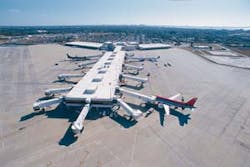Comments a candid Boyd Group International vice president Tim Sieber, “First and foremost, we come from the perspective of saying, you can have all of the incentives in the world; if the market isn’t there, it is not something an airport should use its resources pursuing … because when the incentives run out, so does the airline.” Yet, in certain circumstances, offering incentives for air service can work well, as Sarasota Bradenton International Airport (SRQ) CEO Rick Piccolo attests.
Says Michael Audino, who spent a half a dozen years in the ‘90s as an Iowa state aviation officer, and five years as director of marketing and business development for the Des Moines International Airport, “At the end of the day, and what many communities fail to remember, is that airlines are for-profit entities with a responsibility to their shareholders.”
The overriding theme is that, if a carrier isn’t making money in a particular community, it will not enhance service in that community, relates Audino. So why offer incentives?
“It’s a risky business,” he says. “The fundamental purpose of offering incentives is to help an airline mitigate the risk of sustaining or expanding service. It’s important for communities to start with an honest assessment of their role in the greater transportation system.”
Boyd Group’s Sieber agrees, stating, “Airports should focus on where they can fit in helping an airline make a profitable addition to its overall network strategy.”
Sarasota’s Piccolo says SRQ has had an incentive program for several years, and it has resulted in a number of start-up services. The key to the success there is the targeted nature of its program, and the non-discriminatory way in which it is applied to all its airline carriers.
With regard to regulatory constraints when offering incentives, and the structure of airline/airport incentive agreements, Airports Council International-North America’s (ACI-NA) Monica Hargrove outlined specific regulatory constraints at the ACI-NA finance and economics conference held in Miami last May. Constraints include:
1) Revenue diversion prohibition;
2) Self-sustaining requirement;
3)Unjust descrimination prohibition;
4)Contractual, state, and local law issues;
5)Restrictions on the airport sponsor’s use of non-airport revenues.
[Hargrove’s presentation, titled Airport Incentive Programs: Legal and Regulatory Considerations in Structuring Programs, can be found online at: www.aci-na.org/about/2010_finance.]
Education, Outreach
Audino, who now works with the Center for Urban Transportation Research (CUTR), served as the chair of the project review panel for the Airport Cooperative Research Program’s (ACRP) Report 18: Passenger Air Service Development Techniques. The report, published some 18 months ago, was put together as a guidebook fundamentally designed to help managers, marketers, and air service specialists at smaller airports, relates Audino.
“I contend that any of the findings in the report is relevant to airports of all sizes; and can also be very valuable to local community leaders such as mayors, city councillors, chamber directors, etc.,” he says.
Critical when considering offering incentives for service, relates Audino, is the community’s ability to clearly and specifically articulate its air service goals. “Airports must identify goals and communicate them broadly throughout the community so that everyone is on the same page.”
Audino categorizes specific types of incentives into three broad categories:
1) Revenue guarantee, such as when a community sets aside money, or works with local businesses to purchase a number of tickets; committing a certain amount of money (travel banks). More often than not, the incentive is utilized in support of new service, explains Audino;
2) Cost subsidies such as fee waivers, which can be applied to a variety of service goals;
3) Marketing support, helping promote the airline to the community with paid advertising or other types of airport/airline marketing collaboration.
“It’s important for communities to understand that each incentive has risk associated with it,” adds Audino. “Marketing support tends to be a low-risk investment on the part of an airport; revenue guarantees and travel banks usually require a good chunk of change and are riskier ventures.
“It’s also important for communities to understand that there are no guarantees that incentives will lead to long-term success; failure is an option.
“It’s extremely important for airports to take the lead in educating the community, both the business community and the general public, and helping them understand the fundamentals of air service development.”
Targeting air service at Sarasota Bradenton
“Sometimes offering incentives worked, sometimes they didn’t,” says Sarasota Bradenton Airport president Piccolo. “Overall, our program has worked very well and has enhanced airline service here.
“We used our incentive program and combined it with a Small Community Air Service Development (SCASD) grant back in ’05 to attract AirTran here — now it does more than 400,000 passengers per year.
“We also used our incentive program to help attract Jet Blue here — it serves us year-round, has been here now for three years, and is adding service to Boston in November. AirTran is adding Milwaukee in November.”
Sarasota’s incentive program works like this: “We set up different target markets that we want to get service to and that we don’t already have service to,” relates Piccolo. Then, depending on the number of flights an airline is willing to operate per week, and whether it’s year-round or seasonal, it may qualify for an abatement of so many dollars per passenger enplaned.
“For example, if you’re going to fly twice per day, 52 weeks per year, daily service to say, Detroit, then you would get a $7 per enplanement fee abatement. So you take your rent and your landing fees and all that, and you deduct $7 per enplaned passenger; aircraft size (amount of passengers per aircraft) also applies.
The airport also commits marketing support of up to $500,000 per year for the first year; the marketing support varies from $62,000 to a half a million depending on the level of intensity of the service, says Piccolo.
“We aren’t trying to set up airlines to be in competition with each other, we’re looking to add service to the community,” he says.
Piccolo says the airport has had an incentive program of some sort since 2001. Last year during the downturn, the airport didn’t have any airlines take it up on its offers. “On average, I say we get two carriers per year who will try the incentive program with a particular route,” he remarks.
“I’d say our program has been successful about 75 percent of the time (new service becomes sustainable).
With regard to adjusting the program over the years, Piccolo comments, “In the beginning we were constantly tweaking the program; it was far broader in the early years.
“What we found over time was that we needed to be more targeted; we needed to set a certain number of rules to make it worthwhile to us as well as to the airline — now the program is sophisticated in the sense that it’s very targeted.
“Another key component of the program is that we offer it to any airline, either new or incumbent. Because we focus on the city pair that we don’t currently have service to, we’re not subsidizing competition to an existing city pair here at the airport. Any carrier is eligible to get the incentive for providing service to a new city pair.”
On the marketing front, Piccolo says money comes from interest earnings on the airport’s reserve. “So we don’t use any airline revenue from our carrier activity to help pay for that; it comes out of our own pocket so to speak,” he says.
A consultant’s perspective
Boyd Group’s Sieber says where incentives are most effective is in getting an airline to potentially move an airport up on the pecking order of other markets that the carrier is willing to take a risk on.
“Whether the incentive be fee waivers, marketing support, or risk abatement funds — absent there truly being a market which can be self-sustaining over the long term, we recommend that airports not offer incentives,” relates Sieber.
“Now … if there are two markets that are forecasting out similar metrics, and one market has incentives and another market doesn’t, that’s when an airline could potentially lean towards the one that offers incentives.”
Echoing Audino’s point, Sieber says some incentives are riskier than others, and that’s where programs like the Small Community Air Service Development program have really been valuable.
For example, he adds, “One of the great success stories is with Sarasota Bradenton and AirTran.
“The airport received a SCASD grant, and with those funds on the table, they were able to get AirTran to get into that market. The grant is done now, and AirTran has continued to service Sarasota; not only that, it has actually built its presence at Sarasota without the use of additional funds.
“That’s a situation where Sarasota was able to utilize air service development funding/risk-abatement dollars to get AirTran to try the market from its main hub in Atlanta.
In terms of targeting service, Sieber says incentive programs need to be focused from two perspectives: airports need to identify where air service deficiencies are in the marketplace, and the type of traveler it is attracting to its community.
“Airports have to gather demographics, and identify communities of interest ... on a macro-level in terms of general industries, and then drilling it down to specific corporations.
“We know that the folks in the Midwest and Canadians prefer the Gulf Coast region; the Atlantic and Northeast folks have a propensity for travel to the Atlantic Coast of Florida; etc.
“There’s a lot of data out there; the challenge that we have as consultants is that sometimes people don’t properly read the data, or they may misinterpret the available Department of Transportation (DOT) data; or worse they may be using raw DOT data without really cleaning it up and filtering it.
“We try to bring an informed analysis as it relates to the data, and then layer on top of that a knowledge base of individual airline strategies that will fit the airport’s objectives.”
Sieber says every carrier is very focused on airport cost, so fee waivers are certainly an incentive that comes into play.
“But, once the fee waivers expire, if the costs are not palatable to the operator, the airline may pull out of the market,” relates Sieber.
“The low-cost carriers are very focused on airport costs; this is particularly true when you look at carriers such as Allegiant, AirTran, and Frontier, that have implemented service into specific markets with less than daily strategies.
“The old model was, hang a sign up behind the counter, install some computers, hire some people, and away you go. Now, if an airplane is only coming in once a day three days-per-week, you want a turnkey solution that will be cheap, reliable, and easy to manage.
“The overall goal is to have sort of a wide-stable of air carrier brands and hub choices, as well as the one-off non-stop market that might not necessarily be a hub for a carrier but yet can support that service. The issue is providing as many choices as possible at your airport so that your community’s travel needs are met.”
About the Author

